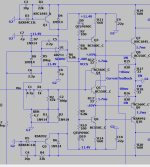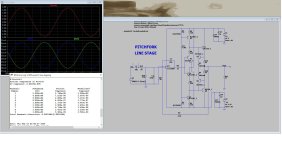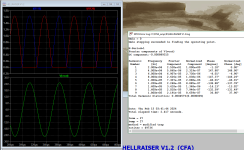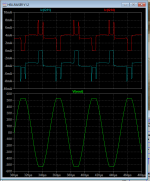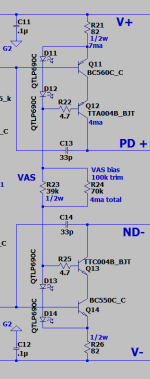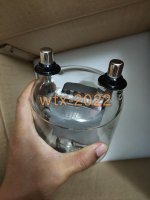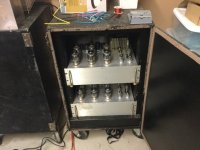at least this design decouples the pre-drivers. Ahhh , a wilson CM based diamond buffer output stage.Works good. 😛
Here in the circuit is a more advanced version of the diamond buffer.at least this design decouples the pre-drivers. Ahhh , a wilson CM based diamond buffer output stage.
Good schematic is this your design?
"This is Jeff Rowland M-9 Amplifier" - see following posts....)))Good schematic is this your design?
The peculiarity of this amplifier is that it is built according to the current source – current amplifier circuit. This is different from a classic amplifier with a differential stage. The sound is very clear and has a signature feature. The input impedance is low, so the source follower was installed on a jfet, I assembled a similar version in 2007 year, only instead of a repeater, I installed a 1:5 interstage transformer at the input; in test comparative listening sessions, this version of the amplifier completely outperformed my friend’s tube amplifier. In the same year, my music lover friends asked me to assemble just such an option from the many amplifier options for its signature sound, but signature sound and high-quality sound are not the same thing, so I still switched to the classic topology but with progressive correction....
So do I. Mix a diamond with a current feedback node (input stage) and get >300V/uS. Fastest CFA I've tested. A DB (diamond buffer) hasI like diamond buffer amplifiers
the drawback of being sensitive to P/N Hfe mismatch and Tc (P/N). I used servo'ed CCS's (below). Without a servo , touching P or N would create
offset.
I also have used DB output stages (below 2) with current sources as class A headphone or reverb driver amps. The DB would have the slew of the op-amp (and the THD). Added about 2 PPM to the op-amp output. 100khz square waves are as sharp as 1K ones !
I just built a SMD DB with Toshiba P/N SMD ( HN1B01F ) matched devices .... perfect - very little offset !
PS - I don't use a DB in my class AB EF3 , it is fast enough to easily handle the slew.
OS
Attachments
Why , did it do this - (like a valve amp-below 1) ? The Russian's circuit also (self) clamps (does not saturate) .... at least in simulation.this version of the amplifier completely outperformed my friend’s tube amplifier.
I've actually built and tested my diamond circuit / VAS. I can clip all day .... led's flash. Close to clip , not harsh.
I use these type circuits to amplify analog synths , very abusive sources .... square/sawtooth/pulse - all sorts of evil harmonics.
Typical forum circuits "stick" and grossly saturate with this abuse.
BTW - I use (below 2) VAS , A CM VAS does the same as it (LED Hawksford) VAS ....
OS
Attachments
To prevent that you should thermally connect Q4 with Q8 and Q5 with Q9.😉So do I. Mix a diamond with a current feedback node (input stage) and get >300V/uS. Fastest CFA I've tested. A DB (diamond buffer) has
the drawback of being sensitive to P/N Hfe mismatch and Tc (P/N). I used servo'ed CCS's (below). Without a servo , touching P or N would create offset.
OS
By the way, yes, it seems to be true.Why , did it do this - (like a valve amp-below 1) ? The Russian's circuit also (self) clamps (does not saturate) .... at least in simulation.
I don’t know why a tube one is worse, I remember my friend’s wife came running from the kitchen and asked whose amplifier this was, that her voice sounded so cool.)))
No issue with the 2 SMD duals right next to each other , I did not do this with the through-hole version. Still it was not bad...To prevent that you should thermally connect Q4 with Q8 and Q5 with Q9.😉
Wish more DIY'ers would build symmetrical designs. Many advantages , better PSRR , general clipping. They do have a different sound in generalBy the way, yes, it seems to be true.
I don’t know why a tube one is worse, I remember my friend’s wife came running from the kitchen and asked whose amplifier this was, that her voice sounded so cool.)))
and close/at overload. The classic APT and 70's NIKKO used a typical LIN input stage (with FET LTP) , followed by a second differential. Then they
level shifted to a similar hawksford cascode. Both even and odd cancelled out in this case.
As far as the Valve amp , you have output trafo's .... control grid overloads. Solid state is far simpler - just control VAS saturation and design the
whole circuit to determine which stage overloads first. I don't understand why some designs use boosted rails for the IPS ..the last thing you want
is for the actual output devices to saturate first. All my amps - the VAS will clip >3V short of the rails , the OPS never saturates. I lose a whole 5V
on my Hawksfords !!
PS - on a valve amp , the output trafo contributes greatly to the "sound" . It can also saturate....
This is true.Wish more DIY'ers would build symmetrical designs. Many advantages , better PSRR , general clipping.
I did hear a Valve amp that truely had some "grunt" ... even <.05% distortion @ 100+ W!!.
-1650V SMPS B+ supply - many amps !! It would kill you !
-Dual 833A tubes with a big toroid output trafo.
It lit the room up , heated the room... too. Damn transmitter Valves !!
But , it was loud and clean like a typical 100W+ class AB SS amp.
I was impressed until the guy told me the tubes cost 1K $$$.
To see how this monster Valve setup on the FFT behaved gave me a reference for my SS amps.
Instead of flashing leds , the 833 plates modulated to the beat ... cool !!
OS
-1650V SMPS B+ supply - many amps !! It would kill you !
-Dual 833A tubes with a big toroid output trafo.
It lit the room up , heated the room... too. Damn transmitter Valves !!
But , it was loud and clean like a typical 100W+ class AB SS amp.
I was impressed until the guy told me the tubes cost 1K $$$.
To see how this monster Valve setup on the FFT behaved gave me a reference for my SS amps.
Instead of flashing leds , the 833 plates modulated to the beat ... cool !!
OS
Attachments
But they can kill you.. I suppose my 500VA 60-0-60V could also kill. but , you would actually have to touch it ! 🙂
You don’t need transmitter tubes or a 1000+ V SMPS to do this. Regular audio tubes and Antek power iron (but real Hammond output iron). Was expecting the usual “bass guitar amp” sound, and my jaw dropped. Damn thing sounded like a Crown Macrotech. So what to do? Build another for stereo of course.I did hear a Valve amp that truely had some "grunt" ... even <.05% distortion @ 100+ W!!.
-1650V SMPS B+ supply - many amps !! It would kill you !
-Dual 833A tubes with a big toroid output trafo.
It lit the room up , heated the room... too. Damn transmitter Valves !!
But , it was loud and clean like a typical 100W+ class AB SS amp.
I was impressed until the guy told me the tubes cost 1K $$$.
To see how this monster Valve setup on the FFT behaved gave me a reference for my SS amps.
Instead of flashing leds , the 833 plates modulated to the beat ... cool !
Next one will be TV tubes, as Russian tubes are now persona non grata.
Attachments
Just a bunch of paralleled valves , 6L6 big guitar amps. Same as 3-5 pair BJT.You don’t need transmitter tubes or a 1000+ V SMPS to do this.
Yes i think we should try to change the name of this thread to class A 100 watt tube amplifier. 🤣And now we are looking, how Class AB 100W amplifier is transforming into Class A 100W tube amplifier. 🤣🤣🤣🤣🤣🤣🤣
- Home
- Amplifiers
- Solid State
- High quality class AB 100 watt amp
